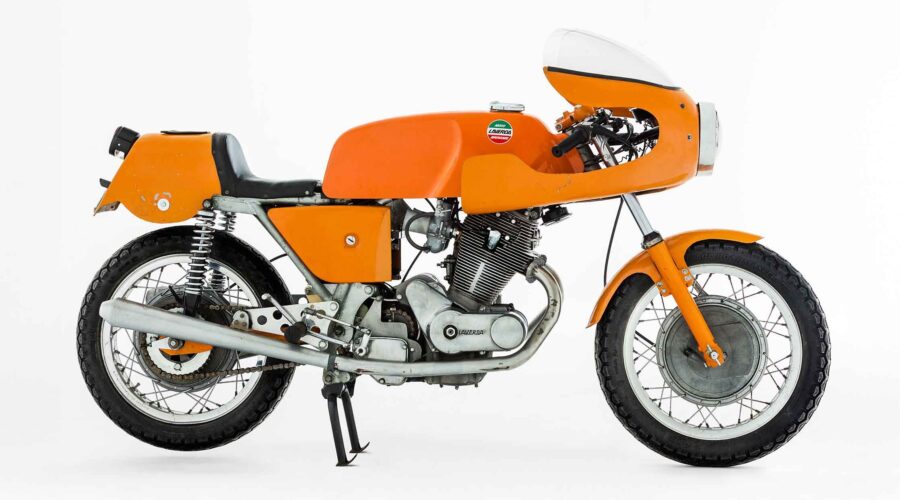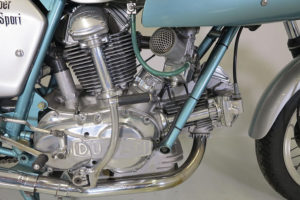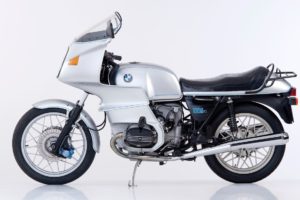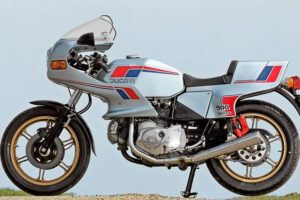1972 Laverda 750 SFC
When Stan Evans came back from a prolonged stay in sunny Italy recently, he took particular care of his briefcase. It was filled with vital statistics on an Italian femme fatale known locally as the “Orange Monster”.
She’s stylish, expensive, responsive and by far the most sophisticated Laverda in Australia. And while Stan, who’s managing director of Melbourne’s Stanco, Australian distributors of the marque, was enjoying sunny Italy and wresting the information from the Italians, we rode the bike.

We’ll tell you the price first, before we get carried away. The Laverda SF-C, the factory 750 production racer, the bike that dominated the Spanish 24-Hour endurance event at Monjuich Park this year, costs $2900 landed in Aussie with its extensive range of spares.
So far Stan has imported two of them. The manufacturers, in their cunning continental way, didn’t send over the specs with the bike. Stan went to Italy to get them (and a few more bikes).
We headed to Calder to try the first of the “Orange Monsters” in the country.
It was supposed to be summer, but turned into one of those cold, misty days to which the Melbournians turn a blind eye and talk about Australian Rules (forgetting everything else).
Stripping down to the bare essentials and stretching on the Astrum leathers nearly did what the old saying said it would — froze the ball bearings off the phosphorbronze monkey — and the bike was feeling it too.
It had to be coaxed into life. No choke assemblies are fitted; the carbs have to be flooded until the motor bursts into life. Even once it is firing and the fuel levels drop in the float chambers the mixture goes extra thin again and the damn thing dies. But even though the bike was built for sunny Italy and not how-do-you-describe-it Melbourne, we finally warmed it up and put its rubber firmly on the track.
The SF Laverda, the sports version of the bike (tested December ’71) is by far the most popular of the two models available in Australia and it’s on this that the production racer has been based.

The bike has been taken from the production line, stripped and rebuilt to more exacting standards incorporating some small style changes that make the 750 SF-C look the part of the winner, and which European competition has proved it to be!
When we tested the SF we were impressed by the standard of handling and braking from this then unknown bike. Although the makers had not risked much by using the superb Ceriani suspension back and front the frame and brakes were unconventional and strictly their own design.
The engine castings are massive and as a unit the engine/gearbox is extremely stiff. By adding large mounting lugs to the cylinder head and gearbox the makers were able to use the mechanicals as a stressed member and do away with double bottom cradle tubework. In the resulting frame design four tubes leave the steering head, but instead of two going down and two reaching back, Laverda’s all go back. The top two are horizontal and extend back to pick up the upper mountings of the rear units. The bottom pair shoot down at 45 degrees to the cylinder head bracket and weave their way over the twin carbs before dropping down to the swinging arm pivot point and gearbox mounting. The tubes are extremely large in diameter and the rigidity of the final structure is total.

Laverda also chose to develop their own brakes. The huge 10- inch diameter twin leaders back and front lack flashy, chrome-plated linkages or a well-known trade name, but perform outstandingly. Both leading shoes are assured of full drum contact by having them self-centralising, operated by the inner and outer cables pulling the cam levers towards each other.
The part that differs visibly from the road model is the very robust brake backing plate with its large stress-bearing ribs. We believe it is the unit developed for Laverda’s 1000 cc three-cylinder bike, which should land in Australia later this year.
The well-designed cooling system is the same as that of the road-going model. An air scoop directs the air flow onto the drum and it flows out through openings in the hub. The result of this extensive development is that the Laverda’s drum brakes are without fault.
Their progression, power and lack of fade sets a standard others are attempting.
On the road the street bike felt good and there doesn’t appear too much race tuning necessary on the frame. The damping and spring rates are different (as you would expect), the brake linings are harder and the track rubber is Dunlop’s triangular TT100s.

The motor’s stage of tune is claimed to be “very nearly that of the SF roadster” but the ultra-large diameter Amal Concentric carbs that replace the touring Dell ‘Ortos are indicative of much more extensive internal development.
We assume that since the cost of this model is $1000 more than the standard SF and only about half of that can be explained away in terms of fibreglass, tyres and incidentals. The remainder must have gone into the motor.
Obviously components such as pistons, valve springs, valves and camshaft have been replaced by hotter ones which would push bhp to about 70, but the work does not finish there. The bike is meant as a 24-hour racer. It has to perform reliably, and that is where the real cost comes in. The vital parts (particularly the crankshaft) are assembled to closer tolerances and a great deal of time is spent in achieving perfect dynamic and static balance.
As is usual from European production racers, no air cleaners are fitted and since the road bike has none (but Stanco will have them available soon) we didn’t really expect to see any on this model, just the large trumpets going to the carbs.
The exhaust system on Laverda’s production racer is the most complex we have seen. Instead of two straight pipes finishing in megaphones, underneath the motor is a criss-cross balancing system. The exhaust system is rubber-mounted and two sets of exhausts come with the bike — street-legal chromium plated mufflers and racing megaphones.
This year the makers have chosen to retain the bulky and heavy 12-volt dvnamo and starter motor – a considerable weight handicap for a long-distance machine, particularly when the huge standard battery is also retained.
It is understood that the 1000 cc three-cylinder model will have a modern, compact and lightweight crank-driven alternator-cum-starter.

To finish off the motor the outside alloy covers, which are thin and non-stress bearing, have cutaways for instant inspection. As a result a mechanic can see at a glance the condition of the starter chain and dynamo belt. The gearbox sprocket and clutch pushrod lever can also be inspected and are accessible through the cutaway in the gearbox cover.
The bike is fitted with rearset footrests and clip-on bars. These controls, like the remainder of the bike, are of the highest quality. Believe it or not a centre stand is fitted. All we can say about it is that removal is easy.
The fibreglass components are the front guard, fairing, petrol tank and seat assembly, the latter incorporating a toolbox in the hump. All these parts are finished in a bright orange, and we were surprised to see the frame finished in what looks like brushed-on aluminium paint. Even if it is a thick coat it looks completely out of character with the remainder of the machine.
Down the straight for the first time the motor was only taken to 4000 rpm in first, second, third and shut off to go around the right-hander at Repco. As we were the first on the track that morning and wary of soft car tyre rubber on the surface it was ever-so-gently leaning into Repco and accelerating out down the back straight. The esses at Toyota were as sweet as ever and Gloweave and the final bend seemed to follow immediately.

After five laps at this steady pace keeping everything below five grand the engine had warmed and the tacho needle began to hit 7000 rpm. We can remember riding the road bike last year quite clearly, especially the hatred the motor had for being over-revved. With the overhead cam design with 9.6 :1 compression we felt it would go far in excess of the 6600 rpm at which it developed its maximum (60) brake horsepower. When we tried taking the revs past 7000 the valves bounced!
With this in mind we were rather dubious about wringing the revs past seven grand, even though a new tacho has been fitted that has a printed red line that begins at 7500 rpm. Incidentally, the road bike we tested was fitted with a Smiths chronometric tacho that had no red line and there was nothing in the manufacturer’s literature about maximum revs.
As the laps went by so did the apprehension and soon hitting 7500 in second and third coming out of Repco and Gloweave was natural as the track had lost its morning dampness. Very soon we were not only taking the engine to its limit but also the braking.
In an effort to find the limit of the braking we had one of those “moments”, which always seems to go hand in hand with sorting out a racer. On this Laverda it happened when trying a bit too hard going in to the big right hander at Repco at the end of the straight. The rear wheel momentarily locked and the bike slewed but stayed upright.
We don’t want to appear to be making an excuse for what was only a natural mistake, but we did state on the initial road test that the powerful 10-inch twin leader at the back end would be a bit too good and unnecessary. Maybe this time we proved ourselves right!
As the morning wore on and the laps rolled by, we learned to live with the track performance of the Laverda. We began to respect the enormous amount of ground clearance at the right-then-left esses, where the bike can be pushed right down. Past the level of necessity — just for academic reasons — the bike would not scrape on either side.
One point did show up as the bike was taken through the esses, where it has to be literally pulled over from a hard right lean to a hard left lean. We felt the 500 lb-odd all-up weight of the SFC would present its problems on a tight, twisty track where a bike has to be thrown around.
But the machine’s racing history is in complete contradiction. The Laverda performs best on tight, twisty tracks.
This is shown by the fact that the works racing team, which fields anything up to six bikes at a time, enters nearly all the European classic races ranging from bike-scraping inner city park tracks to three-figure average speed bowl events, but comes out best at Barcelona.
That race is a 24-hour production event held in Monjuich Park in the centre of Spain’s second city (something like having 100 bikes racing around Melbourne’s Botanical Gardens all Saturday and Sunday). The circuit is tight, twisty and has next to no straights. Lap averages over the 70 mph mark are fast and the race record (average speed and distance) is held by a BSA 500 Gold Star which at nearly 69 mph covered just under 1700 miles.
So tight is the track that the lightweights can successfully challenge the big multis. In 1961, a 125 Ducati led a works R69S BMW home, in 1967 Montessa walked off with first, second and third on their 230s and every year the Spanish factories throw out the most serious challenge on their 250/350 two-stroke singles.
When Laverda made their first serious attack at the race in 1971 their massive effort was rewarded with first, third and fourth. A BSA 500 took out second. Last year an equally massive effort saw second, fourth and sixth overall as a lone surviving 360 racing Bultaco stayed in front to the end. But in their class Laverda finished first, second and fourth, impressive when you consider works teams with much lighter 750s from Norton, Triumph and BMW were also out for victory.
On paper, Laverda’s performance at the track is impossible, but the team has established itself as the one to beat, showing that handling, braking, power and reliability on a big, big bike are more than a match for the versatile lightweights, regardless of the course.
This same works SFC is the one available over the counter in Australia. The cost is substantial but if only the two now in the country make it to the tracks this year, Australia’s booming production racing scene may have a stylish new overlord.
By Derek Pickard. Two Wheels, January 1973.

Falloon: The Classic View
Based on the standard 750 SF, the 750 SFC was conceived as an endurance racer and built to last. Thus the 750 SFC (Super Freni Competizione, or super brakes competition) didn’t share the fragility of some of its Italian competition. It was the success of the SFC in endurance racing from 1971 until 1973 that did much to create the Laverda reputation for robustness and exceptional all round performance.

The bright orange colour scheme of the factory racers would become an SFC (and ultimately a Laverda) trademark. Each SFC was hand-made in batches by the competition shop and while a few were produced from 1971, most were built in 1974 (as seen here) and into 1975.
Based on the production 750 SF, the engine specification was unremarkable, and certainly not as exotic as the desmodromic Ducati or double overhead camshaft MV. When Laverda embarked on the design of a large capacity twin back in 1966, company chief Massimo Laverda had his designer Luciano Zen analyse and copy a Honda 305cc “Super Hawk” parallel twin because it had a proven record of reliability.
Although it differed in a number of design details, the 360-degree parallel twin engine layout was similar to most British twins for example, unlike the British twins the pressed up crankshaft included central roller bearings. Primary drive was by triplex chain, and the single overhead camshaft duplex chain driven.
Other Honda-inspired features included the cast-iron skull combustion chamber. On the 750 SFC the 80x74mm engine included a lighter crankshaft, polished con-rods, and higher compression pistons, and with a pair of 36mm Dell’Orto concentric carburettors the 750 SFC produced a claimed 75 horsepower at 7,500 rpm.
Just about every component was produced specifically for the 750SFC. While the zinc-plated open cradle frame was similar in design to the 750SF, it was quite different, particularly for the 1974 and 1975 versions. These examples also included a larger diameter (38mm) Ceriani front fork, and triple Brembo disc brakes. Although weighing a considerable 230kg, the wheelbase was a moderate 1,460mm and the tall SFC was a competent handler.
Everything about it screamed racing, particularly with the optional two-into-one megaphone exhaust. The rider stretched out over the long 25-litre fibreglass fuel tank to crouch under the lowest fairing screen of any production motorcycle. Although one concession was made to civility, an electric start, the 750SFC was not designed for tooling around town.

Like many Italian manufacturers in the 1970s Laverda was obsessed with the US market and during 1974 the U.S. importer Continental Motors commissioned a North American version. While the engine and chassis specifications were the same as the European model the U.S. specification 750 SFC included 1000 3C Nippon Denso instruments, turn signal indicators, a larger rectangular taillight, and adjustable handlebars.
The 750 SFC was a raw open road motorcycle par excellence. While the big twin vibrated, and the controls were heavy, one ride could convince the rider they were flat out at the Bol d’Or. Stability was unquestioned and the top speed was close to 210 km/h. But eventually time caught up with the 750 SFC. Larger capacity Japanese multis were now winning endurance racers, and Laverda’s own double overhead camshaft 1000 provided more performance.
The hand-built 750 SFC was expensive to produce, and becoming difficult to sell. The 750 twin died, and while the 1000 triple also became an SFC in 1985, Laverda folded soon afterwards. After several botched resurrection attempts Laverda now seems destined to remain in history but the distinctive, beautiful, and functional 750 SFC will never be forgotten.
Ian Falloon is one of the world’s foremost motorcycle historians and valuers, with a particular passion for Italian machinery. Among his many books is the Laverda Twins and Triples Bible. You can see Ian’s extensive range of titles, and get in touch with him if you would like to purchase, here.
Ian also owned a 1974 SFC, which turned up recently at Goodings Auctions in the US. Check it out, and see what it went for, here




